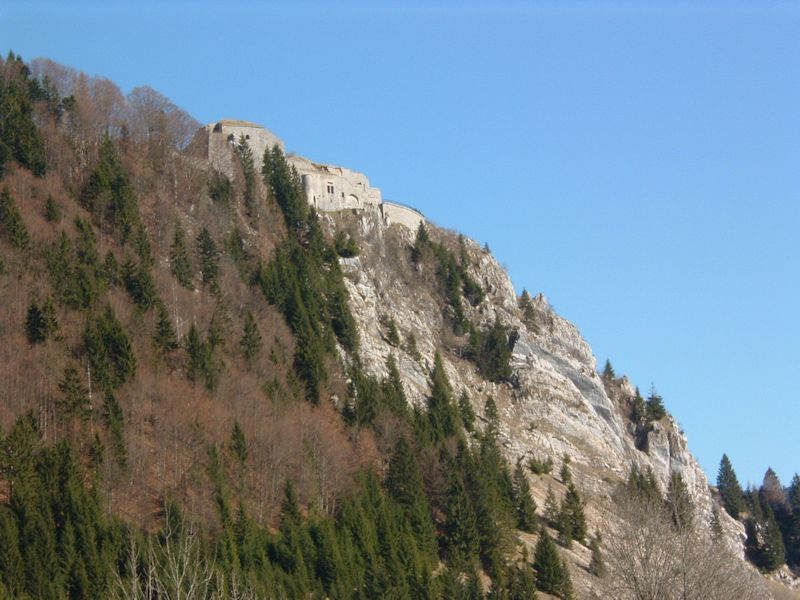|
 Dwight Peck's personal website Dwight Peck's personal website
Castles
of France: the Château de Joux
The
Château de Joux sits on a bluff overlooking the "Cluse de Pontarlier",
and the road beneath is one of the few really good ways through the Jura mountains,
from all of northern Europe through the Franche-Comté region to Vallorbe
in Switzerland and out onto the Swiss Plateau and the Lake Geneva region, eventually
to northern Italy. The TGV fast train to Paris goes right up through here, in
fact. It's always been a good place to have your fortress. Except that, back then,
everybody needs to besiege it!
April 2004

We
first visited in April 2004: There's the Château de Joux in France just
over the mountain from home, on a fine spring day, with not much greenery on the
hillsides.

We
came to see the whole thing, of course, including the deepest inner passageways,
but major EU-supported renovations were underway and we got nowhere near the medieval
parts of it at that time.

From the road that winds up to the castle

The
medieval keep and surroundings are hidden way up there at the top, and we didn't
get to see them on this trip -- just some of the many layers of later accretions,
like the Vauban fort architecture from the later 17th century and the late 19th
century earthworks all around the outside.

Some
of the many layers, April 2004.


The
old tricolor fluttering proudly over the ruins

Now
to get a look at the inside of it.

We were so impressed that we came back two days later, 23 April 2004, hoping to see more of it. But saw even less.


We'll take a rain check.
July 2007

The
Fourth of July 2007, Marlowe and the Old Dad have
come back to see if we can get a proper tour of the place.

A
humble wooden palisade in the 11th century, the big stone centre parts were got
underway in the 12th century, and since that time nearly everyone has had a go
at it.

The
great military engineer Vauban extended matters significantly out from the old
medieval keep in 1690.

See
another major work of Vauban's, Besançon, here.

Only
guided tours here, no wandering about on your own, and here's our excellent young
guide, probably a university student, telling us the old tales in a kind of English
that's much more fun than real English.

And
here's one of the outer layers, enormous earthworks laid on by Joffre in the late
19th century.

A
look at different periods of military architecture piled one upon another as we
march up into the medieval portions

Our
merry guide instructing us as we prepare to charge up the Trick Steps to the highest
level of the old medieval keep -- the stairway has two false steps on it that
can be removed at just the right time to drop attackers into the soup. In fact,
that 15th step from the bottom is called a "ha ha", because that's what
you say when the attackers step on it.

The
fort at Larmont, on the far side of the ravine (or "cluse") of
Pontarlier, built in the late 19th century but now abandoned, with no funds to
restore it.

The
famous author and statesman Mirabeau (1749-1791)
got himself sort of imprisoned here in 1775 for his extravagent lifestyle, and
spent much of his time idling away in that little room on the left, and the rest
of it hanging out in the nearby town of Pontarlier, where he met his "Sophie",
with whom he got into so much semi-pornographic trouble later.

A
view from the parapets down into the ravine below, with the rail line and the
road leading out towards Neuchâtel in Switzerland. The road to the left,
where the big truck is exiting the frame, leads towards Pontarlier and Besançon
in France, and off to the lower right it leads through Vallorbe towards Lausanne
in Switzerland.

The
Château de Joux has a well-known arms museum in it, including a rare rifled
firearm from 1717, though we must have passed that one right by.

A
kitchen

A
maquette of the château, placed improbably way back here in the inner precincts
instead of out where the light can get to it.

Oh,
here's Berthe's room, what a sad tale that one is.
Well, here's the tale as we have heard it told: the lord Amauri III de Joux went
off to the Crusades in about 1170, leaving to wait for him for some unspecified
length of time his young wife Berthe. She did, but some years later a knight (Amey
de Montfaucon) passed by on his return from the Holy Land, got a look at Berthe,
and informed her solemnly that her husband had died of his wounds, probably speaking
her name with his last breath. And then Amey did his very best to comfort Berthe
in her grief, wink wink nudge nudge.
But
alas, Amauri came home again and found . . . well! In a homicidal snit, he hanged
young Amey off the battlements and stuck Berthe into this appalling little cell
("un miniscule cachot où elle ne pouvait se tenir qu'à genoux")
where she couldn't stand up or lie down (but could gaze at her beloved Amey out
the tiny window, as he swung in the breeze). OOoof. When years later the old knight
finally died, Berthe's son let her out of the thing and packed her off to a convent
-- genuine records show a real Berthe de Joux still living in the abbaye of Montbenoît
in 1228, probably not playing with a full deck by that time.

Now
we're dropping down a few levels way back in the middle of the castle.

Here's
a bust of Toussaint Louverture (1743-1803), the former
slave and guerilla leader who led the blacks to victory over the Spanish, English,
and French authorities in Haiti in the late 1790s, moved on to Santo Domingo to
free the slaves there, made a deal with the USA not to invade the South in return
for arms, and established a constitution, with himself in charge of it, over the
whole island of Hispaniola in 1801.

As
our merry guide explains, Napoleon Bonaparte had taken an interest in things out
that way and sent his brother-in-law Leclerc to undermine Toussaint's authority.
In 1802, Toussaint packed it in, signed an agreement with the French, and retired
to his farm. Mistake. Brother-in-law Leclerc swooped
in and rounded him up and transported the trusting fellow to France, in fact,
to this room, where he died of pneumonia in April 1803, as who wouldn't have.
This has been described as the coldest place in France, and you can see the level
of amenities in this cell where he plotted and schemed his return to the tropical
islands throughout the winter.

The
Famous Well. It's 120
metres deep now and used to be higher, up to the top courtyard of the keep, and
was chiselled out by guys hung down in there on ropes until they stopped chiselling
and were replaced (like non-union coalminers in Utah). Our merry guide tottered
out onto that grill, bade everyone to be silent, and dropped a coin down into
the well, and we waited for the sound of it hitting the water. After a while,
I gave it up as a party trick gone awry and started off to see the rest of the
sights, but then I distinctly heard a muffled splash.

Horrible
dungeons in the depths of the Château de Joux -- in fact, these big bricks
on the walls of the prison cell are made of a spongy kind of styrofoam, and the
cell door is an utter fake. It was all put in for a Jean-Paul Belmondo movie some
years ago.

| 
| This
part is real, we're going back out into the sunlight. | Out
in the sunlight at last |
September
2007

Our
Alison's here from Santiago, Chile, for a month of meetings at her European Southern
Observatory headquarters near Munich, Germany, and at conferences in Madrid, Spain,
and Manchester, England, and has scrounged a week free for a visit to the Old
Dad in Switzerland.

It's
a rainy and non-hikey day, so we're looking for a high-yield sightseeing attraction
somewhere nearby and the Château de Joux, first built in A.D. 1034, looks
like a reliable destination, 18 September 2007. There's the "ha ha"
on the right.

Our
nearly hysterical guide just outside the medieval keep -- a lovely local student
who seemed so afraid of losing the thread of her memorized spiel that she fairly
shouted out the same amusing historical stories quasi ad verbum that we
heard a few months ago.

Alison
and a busload of French older persons and very older persons (it's mid-September,
all the working-age people are chiseling away at the mineface.)

Alison
amongst the preceding couple of generations

Within
the medieval keep, Alison passing the cistern and wandering up towards Mirabeau's
cell

Dad,
poised at the door to Mirabeau's cell, snapping wildly away at her

The
cell of Berthe de Joux, the poor lady [see above] whose
husband returned from the Crusades at a very bad moment and locked her up in this
cell for a large number of years to encourage repentant thoughts, and who ended
up in a nearby convent gibbering many years after the old testosteronie's death.

An
overnight in there we could consider an adventure, and maybe laugh it off. Twenty-odd
years would get really get to us.
Poor Berthe.

And
they all made it down, no first responders needed on this trip.

The
cell of Toussaint Louverture
(1743-1803), the former slave and guerilla leader who led the blacks to victory
over the Spanish, English, and French authorities in Haiti in the late 1790s,
moved on to Santo Domingo to free the slaves there, made a deal with the USA not
to invade the South in return for arms, and established a constitution, with himself
in charge of it, over the whole island of Hispaniola in 1801. Napoleon didn't
fall for that one, and the heroic gentleman perished right here of pneumonia.

Alison
trying to photograph the bottom of the well, 120 metres down. Everything turned
out black.
Dad
and Alison at the ancient prison cell, with bricks made of styrofoam. It was got
up in 1995 for the Claude Lelouch film Les Misérables with Belmondo.

An
excellent archway

Another
archway: Dad on the way out, as usual

The
Château de Joux from near the entrance, and the 19th century fort at Larmont
on the far side of the ravine (or "cluse") of Pontarlier.

Zoom
on the fort across the ravine

The
whole ensemble

Alison
with her camera

Dad
with his camera back again

A
last look at the Château de Joux for September 2007
 Feedback
and suggestions are welcome if positive, resented if negative, Feedback
and suggestions are welcome if positive, resented if negative,  .
All rights reserved, all wrongs avenged. Posted 22 August 2007, revised 20 June 2008, 4 February 2014. .
All rights reserved, all wrongs avenged. Posted 22 August 2007, revised 20 June 2008, 4 February 2014.
|
 Dwight Peck's personal website
Dwight Peck's personal website





















































